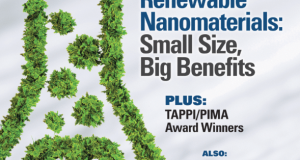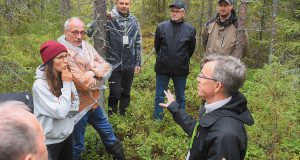Looking Beyond: Change for a More Sustainable World
MARK RUSHTON

Formerly known as PulPaper, the Pulp & Beyond event co-sponsored by the Finnish Forest Products Engineers’ Association (PI) has undergone a massive rethink and is unrecognizable from what it was in years before. This year the conference took place on the first day, with the exhibition on days two and three, allowing visitors to explore the exhibition hall without needing to break off and attend conference sessions.
BIGGER IS NOT NECESSARILY BETTER
The exhibition itself was an innovation—much smaller and more compact, with the emphasis on lowering the carbon footprint of the event. Booths were limited to 40 m2 in area, with a prerequisite that all booth construction materials had to be made from renewable or recyclable materials.
“We decided to dispense of the myth that bigger is better when it comes to booths at events, and our main focus was on sustainability,” said Antti Lindquist, PI’s managing director. “Our aim was to lower the carbon footprint of the event and minimize waste, which is why we asked the exhibitors to make sure the materials they used in their booths were environmentally friendly.”
The event was an outright success, with some 8,000 visitors attending from all over the globe. It was held in conjunction with Helsinki Chemicals Forum and ChemBio Finland, which have ideal synergies with the pulp and paper industries.
THE CONFERENCE
Pretty much everything innovative in the industry was covered through the conference’s main keynotes. First up was the founder and CEO of nova-Institute, Michael Carus, who spoke about the role of biomass, CO2, and recycling carbon waste streams in the renewable carbon concept. The second keynote was Tiina Pursula, Stora Enso’s SVP, packaging materials, who talked about the forest business perspective on responsibility and sustainability. Finally, the subject of sustainability in the financial sector was addressed with an enthusiastic presentation given by Katja Keitaanniemi, CEO of OP Corporate Bank, one of the largest corporate banks in Finland.
The keynotes were followed by three tracks: Innovative Wood-Based Products, Carbon-Zero Future Mills, and International Control Systems Conference 2024.
THE PRESS TOUR
The press tour, organized by well-known industry marketing veteran Teppo Koski, was set up to cover some of the latest issues affecting the industry, as well as the innovations, solutions, and new products being launched into the industry. Here are a few highlights:
Metsä Spring: The tour started off with a conversation with Metsä Spring’s team, headed by CEO Niklas von Weymarn. Metsä Spring is an inspiring, stand-alone company supported by Metsä Group with a mission to find innovative business ideas for forest products—and it’s making great progress. Weymarn said: “We have nine projects on the go within Metsä Spring at the moment, eight of which are public and one that has not yet been released. Two of these projects are in-house and the others are being developed with other partners outside of the Metsä Group.”
One of the most exciting innovations currently taking place at Metsä Spring is the development of Muoto, a three-dimensional, easily recyclable packaging product made from wet wood pulp. A completely new production process has been designed and developed by Metsä Spring in partnership with Valmet, which will take wet pulp and turn it into finished, tailor-made packaging products on one production line.
Jarkko Tuominen, VP of projects at Metsä Spring, said, “We have been proceeding pretty fast with the Muoto project and we are at the exciting stage where we are considering building a commercial-scale plant. We started around four years ago with Valmet as a partner and we have a lot of newly developed technology in the line. The key to success in this area is volume, and we believe Muoto has a great future with tailor-made packaging for all areas of the consumer market.”

In latest news, Metsä Group has selected partners for a pre-engineering project for a potential commercial scale Muoto fiber product plant at its Rauma mill in Finland. The key partners selected are Elomatic, SRV, Valmet Technologies, and A-insinöörit Suunnittelu Oy.
CEPI and the Finnish Forest Industry Federation (FFIF): Next was lunch with CEPI Director General Jori Ringman and FFIF Director General Paula Lehtomäki to talk about the state of the industry in Finland and Europe.
“The industry in Finland has been beset by a number of challenges this year,” said Lehtomäki. “First, we have seen a rapid drop in market demand for a lot of forest products; then we had strikes that closed all the ports, as well as many production plants. The country was actually shut for a month due to strikes. However, the strikes are over and we are also seeing a pick-up in the markets.
“What is really exciting is that the forest products industry is right in the middle of the green transition, and we are seeing so many innovations from our technology companies here in Finland, finding ways to replace fossil-fuel derived products by making them out of wood. We also see a lot of potential in the latest technology for capturing biogenic CO2.”
Ringman spoke about the power of the industry. “The forest product industries in Europe have a lot of muscle; as a coalition, we employ over four million people, and have a turnover of EUR0.5 trillion (about US$550 million). We are at the heart of the green and circular transition, and the European Commission should take note of this as they set their regulations going into the future.”
ABB: Next on the tour was ABB and a meeting focused on the opportunities that its digitalization solutions are offering to industry players, including cost savings, maximizing yield, and emissions reduction. “Almost all industries have the challenges of energy cost, sustainability, regulations, and concern about social reputation,” said Guillaume Carnaille, ABB’s general manager, Europe–Digital. “However, there are solutions with the data driven approach, which is opening the door to higher productivity, a lower carbon footprint, and new business models, as well as providing a solution to the shortage of skilled personnel. The race is really on.”
Carnaille presented a success story about a mill in Spain that carried out an energy audit and subsequently installed ABB’s Energy Management System. Savings totaled nearly EUR290,000 per year (around US$319,000), with electricity savings of 10 percent and natural gas savings of around eight percent.
Another example of ABB digitalization in action—this time with its ABB Real Progress QCS—was presented by Uwe Beekhuis, product manager, who stated that in one customer case a one percent improvement in moisture profile saved a mill EUR400,000 (about US$440,000) a year due to increased production, improved quality, and the reduction of energy use.
ABB has recently launched its “Do More With Digital” campaign to accelerate digitalization across process industries.
Valmet: A presentation by Valmet’s Harri Mustonen, director of pulp and paper control systems, showcased the launch of the company’s latest digitalization offering, DNAe. The new system focuses on interoperability and ease of use for the operator, empowering them to perform at their best. The key cornerstone is the architecture that combines different automation applications into one single platform. “Process control, drive control, end product quality, and safety can all be implemented in one unified platform, with the ability to tailor design dashboards that suit our customers’ needs,” said Mustonen.
The system is compatible with older Valmet DNA systems and offers on-site or cloud solutions. DNAe has been tested on Valmet’s pilot facilities, as well as in the field with a handful of customers already running the system. Feedback so far has been “very positive,” said Mustonen.
The next presentation was given by Virpi Puhakka, director, Ecosystem at Valmet, who talked about the Beyond Circularity program. It’s the company’s largest R&D investment to date, at EUR40 million (US$44 million), with another EUR70 million (US$77 million) invested by its 230 partners. So far there are 28 active projects that have been funded across the program’s seven “streams”: program management, recycling technologies, biorefineries, resource efficient industries, service lifestyle concepts, emerging new process concepts, and disruptive business.
The last Valmet presentation was given by Toni Kotiranta, head of the company’s valve business. The company’s foundation was in the pulp and paper industry, he said, and “now some 75 percent of the world’s pulp goes through our valves.”
Products made at the site include control valves, ball valves, intelligent safety valves, pumps, valve controllers, and actuators, as well as spare parts and services. “There can be as many as 3,500 valves at a pulp mill that all need monitoring for wear and performance,” said Kotiranta.
The meeting concluded with a tour of the Flow Control Business Line factory formerly known as Neles, which Valmet acquired in 2022.
AFT: Aikawa Fiber Technologies, better known as AFT, is a leading equipment supplier of stock prep and wet end technology to the global industry. The press visited its office in Helsinki to talk about the latest developments in screening technology.
Kimmo Nurminen, senior product manager at AFT, spoke about an exciting new AFT product: Diamond Wire™, a wear-resistant treatment designed to extend cylinder life in the screening process. “We are always looking at future challenges our customers will face, and a big one currently facing all our customers is products containing chromium plating, which is not good for the environment and can have detrimental health effects,” says Nurminen.
The company has developed a completely new technology with Diamond Wire that is hexavalent and chromium-free and has proved to be corrosion- and impact-resistant, as well as offering superior wear control. A new production site will start up in Varkaus, Finland, later in the year. Said Nurminen: “We saw this problem coming five years ago as permits for chromium plating are becoming harder to get due to environmental and health concerns. We spent a lot of resources and time developing the Diamond Wire process. We are now manufacturing in Canada and are already delivering chrome-free screening solutions to our customers in North America.”
Andritz: The press tour continued back at the conference center, where we were herded up to the top floor for a meeting with Andritz titled “Pulp Mill of the Future—More Than Just a Pulp Mill.”
Johan Engström, CTO, Andritz, gave us his very interesting view of what a pulp mill will look like by 2040. “We need to make more out of the wood we are bringing into the mill, and with less emissions,” he said. “There are two ways to do this: increase the pulp yield from 50 percent, as it is now, to 70 percent, or make new products from the side streams at mills.
“One of the clear directions ahead is we must utilize all waste at pulp mills and make as many products out of the wood as we can before burning it—for example, by extracting the lignin for uses elsewhere. When we have finally burned the wood, we need to collect the biogenic CO2 emissions to enable even more products to be made; for instance, making fossil-free fuels for aviation or marine applications.”
For the mill of the future, Engström said, we even need to rethink the generation and export of energy to the grid, despite the revenue generated. “It might just be that the energy would be better put to use in making bioproducts that generate even more revenue.”
The collection and use of side streams at pulp mills is becoming instrumental for Andritz as it pursues its CircleToZero initiative, which is aiming at zero waste and zero emissions at pulp mills. The company already offers a number of high-tech solutions to deal with side streams, including SulfoLoop™, which recycles odorous gases and elemental sulfur into commercial grade sulfuric acid; LignaRec™ for the recovery of lignin; and Kraftanol™ for the refining of biomethanol derived from the pulping process.
Bellmer: The press tour finished at lunch with Bellmer CEO Erich Kollmar and senior executives of the company. In a wide-ranging discussion, Kollmar stressed that there is an urgent need for more innovation in the industry.
The machinery company has joined European industry initiative Modellfabrik Papier, which has a mission to make the paper industry carbon neutral by 2024. The initiative was formed three years ago and includes some of the main European paper industry suppliers and producers, including Andritz, Essity, Koehler, Metsä, and Voith. Kollmar said: “The target of the initiative is to reduce CO2. It is more than a ‘think tank’—it’s a ‘make and think tank’, with partners collaborating on ideas and projects to achieve our aims.”
Although the market has dipped recently, said Kollmar, the company has a good forward order book. Bellmer’s recent successes include a major order from Mondi for a new paper machine at its Štětí mill in the Czech Republic, set for startup in 2025.
The press also joined an excursion that visited Metsa Fibre’s Äänekoski mill, Spinnova, and VTT—companies seen regularly in the pages of Paper360°. A more detailed report on the complete Pulp & Beyond show is now available at paper360.tappi.org.



